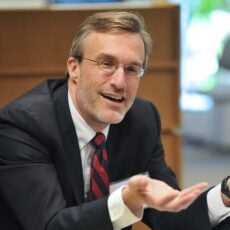
The Legal Limits to State Climate Action
How far can the states go in implementing climate regulations against Washington’s will? Two regulatory experts discuss the legal limits to local climate action.
Over the past 15 months the Trump administration has moved to eliminate or water down a host of environmental regulations tied to energy use. The administration has rejected the Clean Power Plan, sought to relax rules that limit methane emissions from oil and gas wells, and announced that it will lower national car and truck fuel economy standards.
Simultaneously, the federal government has been working to counter state and municipal efforts to strengthen local environmental rules. And recently, concern has been raised that the Environmental Protection Agency, under Secretary Scott Pruitt, might try rescind the waiver that allows California to set its own automotive emissions standards.
Cary Coglianese, director of the Penn Program on Regulation at Penn Law, and Shana Starobin of Bowdoin College, discuss the legal limits to state and municipal efforts to take climate action, and at the tools Washington can use to rein in local regulations. Coglianese and Starobin recently published a related series of essays in The Regulatory Review, State and Local Regulation of Climate Change.
Related Content
State and Local Regulation of Climate Change
Putting Energy into Implementation
Cary Coglianese
Edward B. Shils Professor of LawCary Coglianese is the Edward B. Shils Professor of Law and Professor of Political Science at the Carey School of Law. He also is the director of the Penn Program on Regulation.
Shana Starobin
Assistant Professor, Bowdoin CollegeShana Starobin is an assistant professor of government and environmental studies at Bowdoin College and a former fellow at the Penn Program on Regulation at the University of Pennsylvania Law School.
Andy Stone
Energy Policy Now Host and ProducerAndy Stone is producer and host of Energy Policy Now, the Kleinman Center’s podcast series. He previously worked in business planning with PJM Interconnection and was a senior energy reporter at Forbes Magazine.



